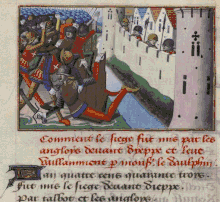Siege of Dieppe
The Siege of Dieppe (2 November 1442 – 14 August 1443) took place during the Hundred Years War. English forces led by John Talbot, Earl of Shrewsbury besieged and failed to capture the French-held port of Dieppe in Normandy.
| Siege of Dieppe | |||||||
|---|---|---|---|---|---|---|---|
| Part of the Hundred Years' War | |||||||
 | |||||||
| |||||||
| Belligerents | |||||||
|
|
| ||||||
| Commanders and leaders | |||||||
|
Charles Desmarets Dauphin Louis |
John Talbot, Earl of Shrewsbury William Peyto (POW) | ||||||
| Strength | |||||||
|
Garrison: Hundreds of men-at-arms[1] Relief army: 1,600 men |
600 men 200 artillery pieces | ||||||
| Casualties and losses | |||||||
|
100 killed Hundreds wounded |
300 killed 14 executed Artillery pieces captured | ||||||
Prelude
The English commander John Talbot, Earl of Shrewsbury marched out with a core troop of 600 men from his headquarters in Jumièges, Normandy at the end of October 1442 to besiege the French-held port of Dieppe.[2] The French garrison of the castle of Charlemesnil surrendered to Talbot's army.[2]
Siege
Talbot built a wooden fort on the heights of Le Pollet east of Dieppe and installed a garrison of 500 men under Sir William Peyto along with 200 artillery pieces of various make and began to bombard Dieppe's fortifications and houses with them.[3]
On 12 August 1443 a French relief army of 1,600 men under the dauphin Louis arrived at Dieppe, which was garrisoned by several hundred men-at-arms led by Charles Desmarets.[1] Two more French armies had reinforced the town previously.[1] At 8 am on 14 August, the French attacked the English fort to the sound of trumpets.[4] The French had five or six wooden bridges on wheels and cranes that hoisted the bridges into position over the English walls.[5] The attacking French troops were repulsed by English missile and arrow fire and lost 100 killed and hundreds wounded.[5]
The citizens of Dieppe reinforced the French army with between 60 and 80 large crossbows and the dauphin ordered the attack renewed.[5] The English were defeated, with 300 killed and 14 French-speaking survivors hanged as traitors on the dauphin's orders.[5] Sir William Peyto, Sir John Ripley and Henry Talbot were captured, among others.[5] The fort was dismantled on the dauphin's orders and the artillery carried off to Dieppe's arsenal.[5]
Citations
- Barker 2010, p. 313.
- Barker 2010, p. 301.
- Barker 2010, pp. 301–302.
- Barker 2010, pp. 313–314.
- Barker 2010, p. 314.
References
- Barker, Juliet R. V. (2010). Conquest : the English kingdom of France in the Hundred Years War. London: Abacus. ISBN 978-0-349-12202-1.CS1 maint: ref=harv (link)